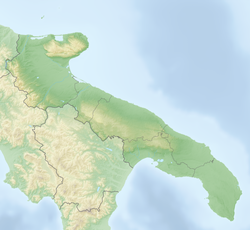| Calcare di Altamura | |
|---|---|
| Stratigraphic range: Coniacian-early Campanian ~ | |
| Type | Geological formation |
| Sub-units | Loferitique, Stromatolique & Gorjanovicia Members |
| Underlies | Calcare di Caranna |
| Overlies | Calcare di Bari |
| Lithology | |
| Primary | Limestone |
| Other | Dolomite |
| Location | |
| Coordinates | 40°48′N 16°36′E / 40.8°N 16.6°E |
| Approximate paleocoordinates | 25°00′N 15°54′E / 25.0°N 15.9°E |
| Region | Apulia |
| Country | |
| Extent | Apulian Platform |
| Type section | |
| Named for | Altamura |
The Calcare di Altamura (Italian for Altamura Limestone) is a Coniacian to early Campanian geologic formation in Italy.[1] The formation comprises limestones that are highly fractured, in places karstified and dolomitized. Fossil ankylosaur tracks have been reported from the formation.[2]
Description
The Calcare di Altamura overlies the Calcare di Bari, separated by an unconformity and is overlain by the Calcare di Caranna, separated by a transgressive angular unconformity.[3][4] The Calcare di Altamura is subdivided into the Loferitique, Stromatolique and Gorjanovicia Members.[5] The formation comprises limestones with some levels of dolomitization. The succession starts with a sequence of stromatolites and is heavily fractured and karstified.[6] The formation crops out south of the Bari–Taranto railway. The lower part of the formation is dated to the Coniacian based on the presence of the microfossils Aeolisaccus kotori, Thaumatoporella parvovesiculifera, Accordiella conica and Moncharmontia appenninica.[7] The upper part is dated to the early Campanian.[5]
Fossil content
The formation has provided ichnofossils of:[1]
- Apulosauripus federicianus[8]
- Ankylosauria indet.[9]
See also
- Dinosaur Quarry of Altamura
- List of fossiliferous stratigraphic units in Italy
- List of dinosaur-bearing rock formations
References
Bibliography
- Reina, Alessandro, and Buttiglione Luigi. 2005. Tecniche geologiche tradizionali nella ricerca di nuovi giacimenti di pietre ornamentali in Puglia. Geologi e Territorio 1/2. 29–40. .
- Weishampel, David B.; Peter Dodson, and Halszka (eds.) Osmólska. 2004. The Dinosauria, 2nd edition, 1–880. Berkeley: University of California Press. Accessed 2019-02-21. ISBN 0-520-24209-2
- Dal Sasso, C. 2003. Dinosaurs of Italy. Comptes Rendus Palevol 2. 45–66. .
- N., N. 2001. Carta Geologica d'Italia 1:50.000 - Catalogo delle Formazioni, 31–55. APAT - Dip. Scienze della Terra, Università di Firenze - Commissione Italiana di Stratigrafia.
- Nicosia, U.; M. Marino; N. Mariotti; C. Murano; S. Panigutti; F. M. Petti; 1999. The Late Cretaceous dinosaur tracksite near Altamura (Bari, southern Italy) I – geological framework. Geologica Romana 35. 231–236. .


